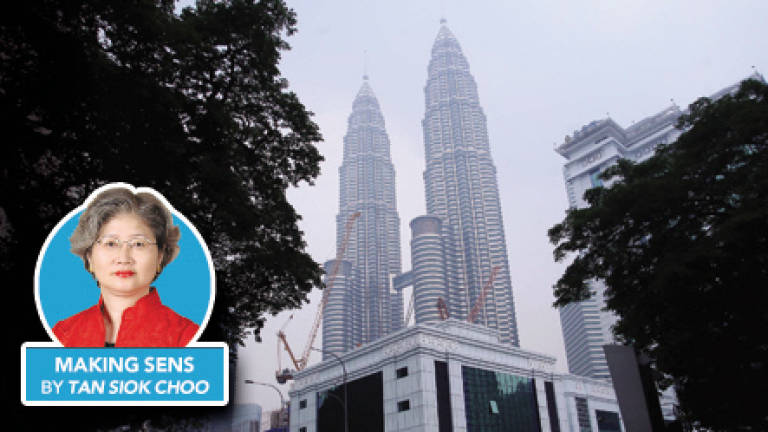Skyscraper curse: Fiction or fact?

COMPLETION recently of the world's fifth tallest building – the 555m high Lotte World Tower in Seoul – amid a miasma of misfortune enveloping its builder the Lotte Group, top corporate honcho of Samsung Lee Jae-Yong and South Korea's first female president Park Geun-hye, has revived talk of the "skyscraper curse".
Is the "skyscraper curse" a myth or mere happenstance? Is it the consequence rather than a catalyst for a combination of ego and economic exuberance? And why do some countries like Japan – where land prices can reach towering heights – appear immune to this urban affliction?
Given that Petronas' Twin Towers – then the world's tallest building – was completed several months after the onset of the Asian Financial Crisis in July 1997 and that plans are now under way to build yet another elevated edifice, the Merdeka PNB 118 Tower, slated for completion in 2020, should Malaysian policy makers be mindful of the "skyscraper curse"?
Andrew Lawrence, an analyst with Deutsche Bank, is credited with conceptualising in 1999 the phrase and documenting the "skyscraper curse".
Studying 100 years of data, Lawrence noted record-height buildings were constructed during boom times when interest rates were low and easy credit was widely available, prompting over investment and speculation. Completion of these towering triumphs, however, coincided with economic downturns.
In New York, the Singer Building and the Metropolitan Life Tower were finalised in 1908 and 1909 respectively, soon after the Financial Panic of 1907, while the Empire State Building was unveiled in 1931, just as the Great Depression took hold.
Additionally, the world's current tallest tower, Burj Khalifa, – previously Burj Dubai, it was renamed after the Emir of Abu Dhabi who helped pay Dubai's debts – was completed in 2009, soon after the onset of the Global Financial Crisis in 2008.
Meanwhile, South Korea's two largest chaebols – Samsung and Lotte – as well as former president Park Geun-hye are experiencing a torrid time.
After the constitutional court last month upheld parliament's impeachment of Park, the country's first democratically-elected president to be ousted from office, she is now held in a detention centre and faces questioning over charges of bribery, extortion and abuse of power.
Also incarcerated were Samsung's de facto head Lee Jae-Yong and four executives. Lee faces several charges, including paying US$36 million in bribes to Park's close confidante Choi Soon-Sil to obtain official approval to merge two Samsung units; a move to consolidate the Lee family's control over the network of companies.
Lotte's trifecta of trouble offers yet more persuasive evidence of the "skyscraper curse".
First, Shin Kyuk Ho, the 94-year-old founder, and three of his children face a welter of charges, including embezzlement, fraud and tax evasion.
Second, 90 out of the chaebol's 99 retail stores in China were closed – allegedly for safety reasons although many believe the closure reflects Beijing's ire against the US Terminal High Altitude Area Defence anti-missile system installed in South Korea on land owned by Lotte.
Third, the opening of the Lotte World Tower – scheduled on March 22 this year – had to be deferred to April 3 when an elevator malfunctioned.
Several academics suggest constructing continually higher buildings stems from surging land prices and the consequent need to maximise land usage.
If true, why is Japan – home of some of the world's priciest real estate – a notable exception to the "skyscraper curse?"
In 1989, the land value of the Imperial Palace in Tokyo exceeded that for the whole of New York. Instead of extending upwards in 1989 and 1990, the Japanese expanded outwards – paying exorbitant prices for overseas trophy properties including US$1.4 billion for an 80% stake in the iconic Rockefeller Centre in New York and US$841 million for California's famed Pebble Beach golf resort.
Some academics argue building super skyscrapers does not cause an economic crisis, that the conjunction of erecting these steel-and-glass pinnacles and the onset of economic crisis are part of a common trend or "cointegrated."
Others suggest skyscrapers are akin to the canary in a mine – an indicator of possible toxic conditions below.
In 2020, two skyscrapers are likely to be completed – the now delayed Jeddah Tower in Saudi Arabia that could displace Dubai's Burj Khalifa as the planet's loftiest behemoth and Malaysia's newest and tallest edifice, Merdeka PNB 118 Tower.
In their article titled "Is There Such A Thing As A Skyscraper Curse?" Elizabeth Boyle, Lucas Engelhardt and Mark Thornton suggest among signs of a turn in the business cycle are "skyscrapers, which serve all at once as a monument to the successes of the past and as a harbinger of the suffering that is to come".
Given the slowdown in the Malaysian economy since 2014 and a projected oversupply of office space in Kuala Lumpur, is there still time to prevent Merdeka PNB 118 Tower from providing yet more fodder for those studying the "skyscraper curse?"
Opinions expressed in this article are the personal views of the writer and should not be attributed to any organisation she is connected with. She can be contacted at siokchoo@thesundaily.com